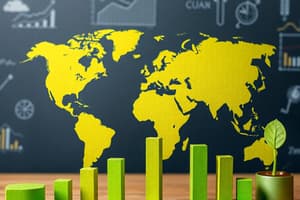Podcast
Questions and Answers
What are some of the main economic decisions people typically make on a daily basis?
What are some of the main economic decisions people typically make on a daily basis?
People typically make economic decisions each day on how much to spend and save, the type of food to buy, which school to enroll, how much time to spend working and how much time to spend on leisure, as well as many more decisions that directly relate to their lives.
Describe the difference between Economic Goods and Free Goods.
Describe the difference between Economic Goods and Free Goods.
The main difference between economic goods and free goods is scarcity. Economic goods are scarce, meaning that there is a limited supply of them relative to the demand for them. This means that they have a price attached to them. Free goods, on the other hand, are abundant and freely available to everyone, so they do not typically have a price. For example, air is a free good, while air-conditioned air is an economic good.
What are the four main factors of production in an economy?
What are the four main factors of production in an economy?
- Land, Labor, Resources, and Technology
- Land, Labor, Capital, and Entrepreneurship (correct)
- Land, Labor, Capital, and Human Resources
- Land, Labor, Capital, and Technology
Explain the concept of scarcity in economics.
Explain the concept of scarcity in economics.
What is the difference between microeconomics and macroeconomics?
What is the difference between microeconomics and macroeconomics?
What are the three main types of economic systems as described in the text?
What are the three main types of economic systems as described in the text?
Explain what is meant by opportunity cost in economics.
Explain what is meant by opportunity cost in economics.
What are three common problems that economies face in the development of products and services, as mentioned in the text?
What are three common problems that economies face in the development of products and services, as mentioned in the text?
What is the difference between positive economics and normative economics?
What is the difference between positive economics and normative economics?
What is Gross Domestic Product (GDP)?
What is Gross Domestic Product (GDP)?
What is the difference between GDP and GNP?
What is the difference between GDP and GNP?
What are the four common economic issues, mentioned in the text, that applied economics can be used to attempt to solve?
What are the four common economic issues, mentioned in the text, that applied economics can be used to attempt to solve?
What is the meaning of poverty in economics?
What is the meaning of poverty in economics?
What are the key factors that can contribute to poverty?
What are the key factors that can contribute to poverty?
What are some potential solutions to the problem of poverty?
What are some potential solutions to the problem of poverty?
What is meant by unemployment in economics?
What is meant by unemployment in economics?
What are some common causes of unemployment?
What are some common causes of unemployment?
Outline some potential solutions to tackle the economic problem of unemployment.
Outline some potential solutions to tackle the economic problem of unemployment.
What is inflation in economics?
What is inflation in economics?
What are the key factors that can cause inflation?
What are the key factors that can cause inflation?
What are some measures that can be taken to address the problem of inflation?
What are some measures that can be taken to address the problem of inflation?
What is income inequality in economics?
What is income inequality in economics?
Explain the key causes of income inequality.
Explain the key causes of income inequality.
What are some potential solutions to address income inequality?
What are some potential solutions to address income inequality?
What is meant by demand in economics?
What is meant by demand in economics?
What is meant by supply in economics?
What is meant by supply in economics?
Define the concept of market equilibrium.
Define the concept of market equilibrium.
What is the meaning of price in economics?
What is the meaning of price in economics?
Explain the law of demand in economics.
Explain the law of demand in economics.
What is the meaning of the term “ceteris paribus” in economics?
What is the meaning of the term “ceteris paribus” in economics?
What are the key factors that can affect the demand for a good or service?
What are the key factors that can affect the demand for a good or service?
What is the law of supply in economics?
What is the law of supply in economics?
What are the key factors that can affect the supply of a good or service?
What are the key factors that can affect the supply of a good or service?
Define the concept of the price of production inputs.
Define the concept of the price of production inputs.
How can taxes affect the supply of a good or service?
How can taxes affect the supply of a good or service?
Explain how technology can affect the supply of a good or service.
Explain how technology can affect the supply of a good or service.
How can expectations affect the supply of a good or service?
How can expectations affect the supply of a good or service?
What are the main differences between a traditional, command, and market economic system?
What are the main differences between a traditional, command, and market economic system?
Why is it important to understand the importance of economics in our daily lives?
Why is it important to understand the importance of economics in our daily lives?
Provide some examples of how applied economics can be used to solve real-world problems.
Provide some examples of how applied economics can be used to solve real-world problems.
Why is it important to be a good consumer in an economy?
Why is it important to be a good consumer in an economy?
How can understanding economics guide government policy?
How can understanding economics guide government policy?
Explain the concept of 'opportunity cost' using a real-world example.
Explain the concept of 'opportunity cost' using a real-world example.
What are some of the ways that the government can try to address the problem of income inequality?
What are some of the ways that the government can try to address the problem of income inequality?
Flashcards
Economics
Economics
The study of how individuals manage resources to meet needs.
Microeconomics
Microeconomics
Focuses on individual markets and decision-making by households and firms.
Macroeconomics
Macroeconomics
Examines the economy as a whole, looking at aggregates like GDP and total employment.
Opportunity Cost
Opportunity Cost
Signup and view all the flashcards
Production
Production
Signup and view all the flashcards
Consumption
Consumption
Signup and view all the flashcards
Distribution
Distribution
Signup and view all the flashcards
Scarcity
Scarcity
Signup and view all the flashcards
Goods
Goods
Signup and view all the flashcards
Utility
Utility
Signup and view all the flashcards
Demand
Demand
Signup and view all the flashcards
Supply
Supply
Signup and view all the flashcards
Market Equilibrium
Market Equilibrium
Signup and view all the flashcards
Equilibrium Price
Equilibrium Price
Signup and view all the flashcards
Positive Economics
Positive Economics
Signup and view all the flashcards
Normative Economics
Normative Economics
Signup and view all the flashcards
Inflation
Inflation
Signup and view all the flashcards
GDP
GDP
Signup and view all the flashcards
GNP
GNP
Signup and view all the flashcards
Expenditure Approach
Expenditure Approach
Signup and view all the flashcards
Income Approach
Income Approach
Signup and view all the flashcards
Market Demand
Market Demand
Signup and view all the flashcards
Demand Curve
Demand Curve
Signup and view all the flashcards
Law of Demand
Law of Demand
Signup and view all the flashcards
Factors Affecting Demand
Factors Affecting Demand
Signup and view all the flashcards
Law of Supply
Law of Supply
Signup and view all the flashcards
Factors Affecting Supply
Factors Affecting Supply
Signup and view all the flashcards
Market System
Market System
Signup and view all the flashcards
Economic Issues
Economic Issues
Signup and view all the flashcards
Income Inequality
Income Inequality
Signup and view all the flashcards
Study Notes
Introduction to Applied Economics
- Economics is a social science concerned with how individuals and societies organize scarce resources to meet human needs.
- It involves decision-making about spending, saving, food choices, education, work, and leisure.
- Economics is crucial for understanding societal issues and creating successful economic policies.
Scope of Economics
- Microeconomics examines individual markets (e.g., rice market).
- Macroeconomics studies the entire economy as a whole (e.g., Philippine economy).
Economics as a Science
- Economics uses scientific methods (observation, hypothesis, experimentation) to understand economic principles.
- It's a social science because it studies human behavior and societal structures.
- Economic analysis describes events using logic rooted in systematic relationships.
Economic Resources
- Economists categorize resources into land, labor, capital, and entrepreneurship.
- Land refers to natural resources (e.g., soil, minerals).
- Labor encompasses human effort (e.g., workers, laborers, employees).
- Capital includes man-made goods used in production (e.g., machinery, equipment).
- Entrepreneurship is the ability to organize other resources to produce goods and services.
- Resources are often scarce, leading to economic choices.
Economic Agents
- Consumers purchase goods and services.
- Producers create and sell goods and services.
- Governments influence economic activity through taxes, regulations, etc.
Economic Systems
- Traditional economies base decisions on customs and traditions.
- Command economies are centrally planned, with the government making most economic choices.
- Market economies rely on individual decisions based on supply and demand.
Types of Economics
- Household economics focuses on family management.
- Business economics studies company operations.
- National economics analyzes entire countries.
- International economics involves trade and relations among countries.
Economic Concerns
- Production involves using inputs to create outputs.
- Distribution involves allocating products among members of society.
- Consumption is the final use of goods and services.
- Public finance deals with government revenue and expenditure.
Economic Issues and Policies
- Poverty is a lack of financial resources for basic needs.
- Unemployment occurs when people are willing to work but can't find jobs.
- Inflation is a general rise in prices.
- Income inequality refers to the unequal distribution of income among individuals.
- Governments develop policies to address these issues.
Utility and Application of Applied Economics
- Economics addresses fundamental questions about what, how, and for whom to produce.
- There are diverse and complex economic systems.
- Economists use various approaches to study and apply economics concepts practically.
Market Demand, Market Supply, and Market Equilibrium
- Demand is the consumer's willingness to buy a good or service at a particular price.
- Supply is the seller's willingness to offer a good or service at a particular price.
- Equilibrium occurs when supply and demand balance, creating a stable price.
- The equilibrium point is where quantity supplied equals quantity demanded.
- The law of demand shows a negative relationship: lower prices mean higher demand and vice versa.
- The law of supply indicates a positive relationship: higher prices mean higher supply and vice versa.
- Market equilibrium is an important part of market theory.
Studying That Suits You
Use AI to generate personalized quizzes and flashcards to suit your learning preferences.




